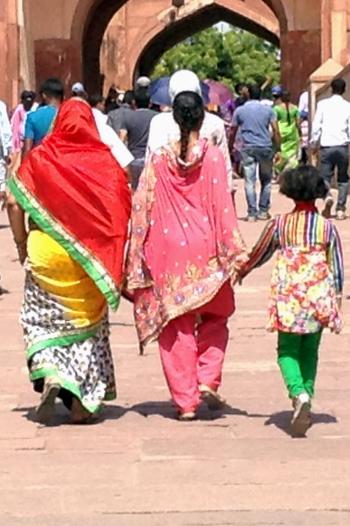Fabric of life
Duration/age

Many cultures share and tell their stories through the colour, designs, placement and patterns printed or woven into their fabric and cloth.
The fabric can tell you the story of where a person lives, what animals or food can be found in the environment and who they are connected to. It can even tell you the age and status of the person wearing the cloth.
Next time you are out and about try to find some interesting or unusual fabrics to talk about. You can also look in a book.
As you look at the different cloth or fabric talk with your child about the many different details. What colours can you see? Are there lots of colours or just one colour? Can you see patterns, pictures or symbols on the cloth? Explore what you think the colour choice is saying. Is it telling you about the time of the year, day or the weather?
I can see fish and shells on the cloth. I wonder if the people lived near the sea.
Talk with your child about when and where the people might have worn the cloth. Did they wear it every day or was it only worn on special occasions?
The colours on the kimono are browns and earth tones. I think this might have been worn in autumn.
I think this was only worn by women. The colours and symbols are very soft and flowing.
See if you can work out what the story of the cloth is trying to tell you. Do you and your child come up with the same story?
Materials you will need
- Fabric
- Textiles
- Material
Alternative tools
- Pictures
- Books
Skills this activity improves
Why does this matter?
Exploring the messages and meanings printed on fabric and cloth helps your child to understand that stories can be told in different ways.
As you explore the designs, symbols and colours on the cloth your child will be developing their language and observational skills. They will begin to understand that symbols and pictures convey a message.
What does this lead to?
As your child grows older, understanding the different ways language can be presented will help them to make decisions on how to organise or record their thinking. Exploring the stories recorded on the fabric helps them to develop rich oral language and to use this in their general conversations with others.
Sharing traditional and important stories from your own culture and family helps your child to develop a strong cultural identity. The sharing of family and cultural stories helps to keep the stories alive and to pass on important information about the family, behaviours and traditions that are often not written down.
Talking together about what you have noticed on the cloth helps your child to ask questions. As they notice objects they can group them and compare the differences. As they talk about what they notice they are developing language to describe their thinking and observations.
Language to use
- Pattern, symbol, design, picture, motif
- Daily life, daily routine, ceremonial use, celebration
- Cloth, fabric, material, carpet
- Decorative, functional, clothing, ceremonial
- Geometric, lines, angles, spaces, symmetrical
- Colour, texture, shading, light, dark, mottled, contrast
- Cotton, wool, silk
- Dye, print, stamp, embossed, weave, sew
Questions to use
- Who might wear this?
- When would they wear it?
- What can you see on the cloth?
- Where do you think the person would live?
Useful tips
- You can find different cultural textiles and fabrics at the South Australian Museum and the Art Gallery of South Australia.
- You might also like to take a look at the activities Storytelling stones and Telling stories.
- For more information on textiles, cultural identity and patterns visit your local library or look online.
- Many stories and traditions about producing cloth and patterns aren't recorded or written down. They are passed on orally. Take some time to talk to other families and friends to find out their stories.
- Remember to talk to your child in your home language.
More ideas
- Visit the Yuendumu School Doors at the South Australian Museum. Try and work out the stories told on the Doors.
- Make your own cloth. Try tie-dying and then drawing on the cloth with fabric markers.
Variation by age
Three to five year olds
- Design your own family flag to fly out the front of your house.
- Make your own cloth and clothing for your child’s dolls or stick people. You can use them when you tell stories and to help make up stories of your own.
- Use your fingers to make designs in shaving cream or fingerpaint. Take a print of them before you wipe them off.
- Make your own stamps to create fabric patterns. You could use sponges or found objects or you can cut shapes into ice-cream lids.
- Borrow books from the library that explain what the fabric means.


